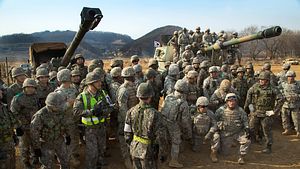The U.S. and Republic of Korea (ROK) militaries kicked off their annual Foal Eagle/Key Resolve joint military drills simulating war on the Korean Peninsula on April 1 following a decision to postpone the exercises by a month to avoid overlapping with the Winter Olympics in South Korea.
Despite the Pentagon’s claim that the drills will be on the “same scale, scope and duration as previous years,” Foal Eagle has been shortened to a month and will not involve U.S. military hardware considered by the North Korean regime to be especially threatening (so-called strategic assets) including nuclear-powered aircraft carriers, nuclear-powered submarines and U.S. strategic bombers such as the B-1, B-2 and B-52.
Carriers, subs, and bombers are seen by North Korea as overtly provocative as they would be key U.S. military assets in any preemptive-strike scenario against the regime in Pyongyang. However, Foal Eagle will see the participation of U.S. Navy’s Wasp Expeditionary Strike Group (ESG), which is slated to deploy for a landing exercise at Pohang in South Korea’s North Gyeongsang Province this month. As I reported in March:
Wasp-class amphibious assault ships have taken part in joint U.S.-ROK military exercises in the past. However, this would be the first time operating F-35Bs from its flight deck. F-35s have participated in military drill in South Korea before.
The F-35B, he U.S. Marine Corps’ short take-off and vertical landing (STOVL) variant of the supersonic fifth-generation F-35B Lightning II Joint Strike Fighter, is considered a strategic asset by the North, and as my colleague Ankit Panda has pointed out, Pyongyang’s reaction to the deployment of the USS Wasp and its F-35Bs fighter jets is worth paying attention to.
The Foal Eagle exercises will see the participation of around 11,500 U.S. and approximately 300,000 ROK troops and last for about four weeks, whereas the computer-based Key Resolve command-and-control exercise will last for two weeks and include 12,200 U.S. and 10,000 ROK troops. Key Resolve is expected to kick off in mid-April.
It is unclear whether the exercises will include simulated surgical strikes against North Korea’s nuclear, missile and command and control facilities, as well as ‘decapitation’ raids by Special Operations Forces to neutralize North Korea’s senior leadership as part of the so-called Korea Massive Punishment & Retaliation (KMPR) plan to be executed in the event of war with North Korea. This would also involve the use of precision-strike weapons including ballistic and cruise missiles:
In the event of a North Korean nuclear attack (or even signs of preparations for one), KMPR specifically calls for surgical strikes against key leadership figures of the communist regime and military infrastructure with the missiles part of a so-called kill chain consisting of integrated information, surveillance, and strike systems, as well as the Korea Air and Missile Defense (KAMD) system.
The Foal Eagle and Key resolve battle drills are conducted in accordance with the ROK-U.S. Mutual Defense Treaty, signed in October 1953.

































